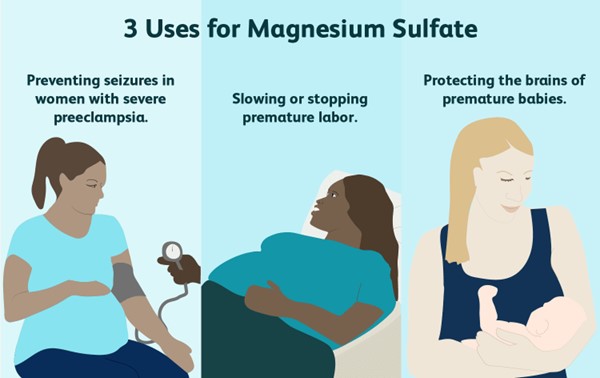Magnesium sulfate is given to women with preeclampsia and eclampsia to:
Improve patellar reflexes and increase respiratory efficiency
Shorten the duration of labor
Prevent and treat convulsions
Prevent a boggy uterus and lessen the lochial flow
The Correct Answer is C
Magnesium sulfate is given to women with preeclampsia and eclampsia to prevent and treat convulsions.

Magnesium sulfate is a mineral that reduces seizure risks in women with preeclampsia. A healthcare provider will give the medication intravenously. Sometimes, it’s also used to prolong pregnancy for up to two days. This allows drugs that speed up your baby’s lung development to be administered.
Choice A is wrong because magnesium sulfate does not improve patellar reflexes or increase respiratory efficiency. In fact, it may cause decreased or absent deep tendon reflexes and respiratory depression as side effects.
Choice B is wrong because magnesium sulfate does not shorten the duration of labor. It may actually prolong labor by inhibiting uterine contractions.
Choice D is wrong because magnesium sulfate does not prevent a boggy uterus or lessen the lochial flow. It has no effect on uterine tone or bleeding after delivery.
Nursing Test Bank
Naxlex Comprehensive Predictor Exams
Related Questions
Correct Answer is ["A","C","D","E","F"]
Explanation
A health history is a holistic assessment of all factors affecting a patient’s health status, including information about social, cultural, familial, and economic aspects of the patient’s life as well as any other component of the patient’s life style that affects health and well-being.
Choice B is wrong because physical assessment is not part of the health history, but a separate process of examining the patient’s body systems.
Choice A is correct because review of systems is a systematic method of collecting data on all body systems.
Choice C is correct because sexual history is an important aspect of the patient’s health that may affect their risk for sexually transmitted infections, reproductive health, and psychosocial well-being.
Choice D is correct because height, weight, BMI data are part of the biographical data that provide a baseline for comparing the patient’s characteristics to established norms for physical and emotional health.
Choice E is correct because diet and nutritional intake are relevant factors that influence the patient’s health status and may indicate potential problems such as malnutrition, obesity, or eating disorders.
Choice F is correct because family medical history provides information about the patient’s genetic risk for certain diseases and conditions that may affect their current or future health.
Correct Answer is C
Explanation
The patient is showing signs of magnesium toxicity, such as respiratory depression, hyporeflexia, and flushing.
Magnesium sulfate is a high-alert medication that can cause serious adverse effects if not monitored closely.
The nurse should stop the infusion immediately and notify the provider.
Choice A is wrong because calling for a stat magnesium sulfate level will not address the immediate problem of toxicity.
The nurse should act quickly to prevent further complications.
Choice B is wrong because administering oxygen will not reverse the effects of magnesium toxicity.
Oxygen may be helpful for respiratory distress, but it will not correct the underlying cause.
Choice D is wrong because hydralazine is an antihypertensive medication that lowers blood pressure.
The patient’s blood pressure is already within the normal range for a pregnant woman with preeclampsia (140-160/90-110 mm Hg).
Hydralazine may cause hypotension and fetal distress.
Whether you are a student looking to ace your exams or a practicing nurse seeking to enhance your expertise , our nursing education contents will empower you with the confidence and competence to make a difference in the lives of patients and become a respected leader in the healthcare field.
Visit Naxlex, invest in your future and unlock endless possibilities with our unparalleled nursing education contents today
Report Wrong Answer on the Current Question
Do you disagree with the answer? If yes, what is your expected answer? Explain.
Kindly be descriptive with the issue you are facing.
